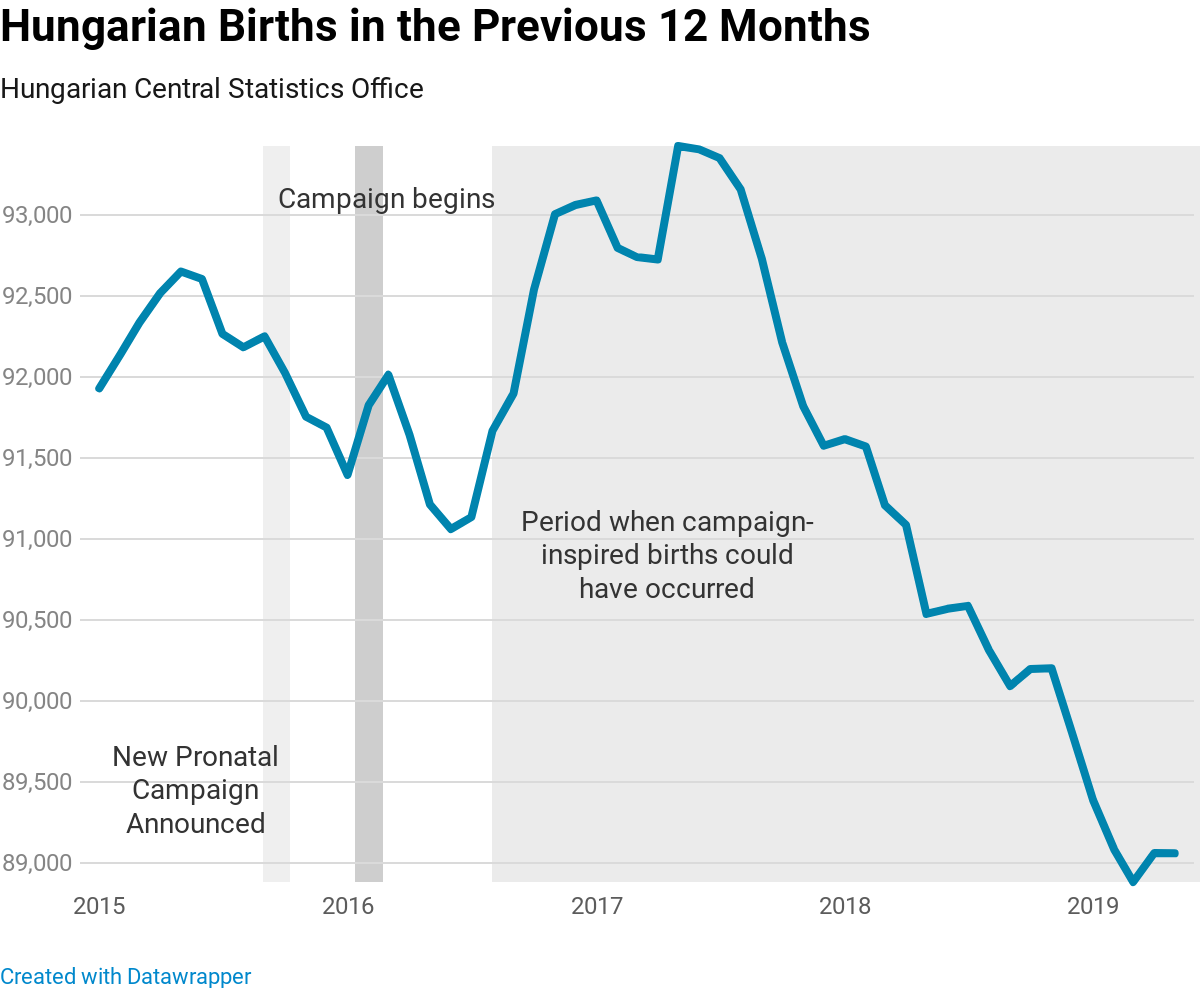
Hungary has recently implemented a new-and-improved policy to encourage people to have more children: Couples will receive $30,000 if they have three more kids. But this program is probably going to fail at raising Hungary’s birth rate, just like previous programs.
Despite the enthusiasm some conservatives such as Tucker Carlson have expressed for it, this policy, like many of Hungary’s other “pro-natal” policies, is Potemkin pronatalism. It won’t increase Hungary’s birth rate.
For several years, Viktor Orbán’s government has embarked on a campaign to try to lift the country’s birth rate through a variety of channels. I’ve been critical of these efforts, for a number of reasons. For example, despite the fanfare, spending on child benefits has been mostly flat in Hungary. More to the point, many benefit programs seem more calculated to subsidize favored businesses than to boost childbearing.
Rather than give families cash, the Hungarian government gives families loans, which they can use to buy government-approved items. If families have enough children, the government forgives the loans, which it has done previously with subsidized loans for new houses (construction) and large vans (the auto industry). Under the new policy, the Hungarian government is offering a $30,000 loan to families to use on anything.

Thus far, Hungary’s best efforts to boost the birth rate have failed. To understand why, we must look under the hood at how they really work. The branding for the new program suggests families get $30,000 to have three kids. The reality is far more complex.
Few Families Will Qualify
A Hungarian woman can obtain a $30,000 loan when she becomes pregnant if she is in her first marriage, is between the ages of 18 and 40, and has a spouse who’s been employed for several years and has a middle-class income. How many women actually fall into this category?
Compared with an earlier Hungarian program that offered a tax benefit for employed women with four or more kids, the actual number of women who will qualify for this new one is probably small. So, for example, in 2018, only about 3-4 percent of Hungarian women younger than age 50 had four or more children.
It’s hard to say what share of them were employed; overall, about 65 percent of Hungarian women ages 15-50 are employed. That percentage is probably lower for women with many children, which means at best this tax exemption applied to 1.5-2 percent of women. Yet the government proclaimed it as if it were some sweeping new policy.
The new loan program is similarly narrow. It applies to married women in their first marriage, between the ages of 18 and 40. In practice, many births occur to mothers older than age 40 or younger than age 18, and many births are to unmarried mothers. Thus, this program only potentially applies to about 30% percent of reproductive-age Hungarian women at any given time.
About 75-80 percent of Hungarian women will end up having been married by age 40, so a large number would be exposed if the program continues for a long time. The government has only scheduled it to run until 2022, however, so 30 percent should be an accurate depiction.
That said, 30 percent is probably too high: These benefits only apply to a first marriage. An unknown share of those married women may be married to a second, third, or subsequent partner. Furthermore, some lower-income families would not qualify due to work requirements. In other words, probably less than a third of Hungarian women would even be eligible for these benefits, let alone claim them.
And what percentage of women will end up having three children? It’s hard to say. Obviously, if it works, this new program and others would raise the percentage. But historically, the share has been about 20-25 percent of women. And some of those likely had children out of wedlock or after age 40 or before age 18. In other words, the share of women likely to be eligible to participate in the program and to accomplish the requirements to receive the full benefit is probably very low, likely less than 15 percent of women.
The government makes the policy out to be a big, sweeping program. But when you do the math, that simply isn’t the case. That’s why I call it Potemkin pronatalism. It’s a lot of wishful thinking, not a lot of substance.
Spending Money They Don’t Have
Aside from its narrow eligibility, the new benefit program, like older programs, is a bit tricky to understand because it’s a loan. The government isn’t actually giving families cash. It’s giving them cash upfront, contingent upon future behaviors. This changes how families think about the policy.
If parents take the $30,000, they don’t owe any payments until three years after their next child is born, and if they have a second child, they get three more years. If they have a third child, the loan is forgiven. That’s the $30,000.
But if the clock runs out on the parents before they have a third child, they must pay back the whole loan, with interest, within 120 days. In other words, it’s a financial gun to the head of Hungarian couples. Once they take the loan, they’re on the hook. If for some reason they don’t have the babies they committed to in time, they owe an enormous amount of money in an incredibly short window of time.
The government offers an exemption for medical inability, which seems ripe for abuse, but a couple might not achieve their fertility goals for a number of legitimate reasons. Likewise, in the case of divorce, couples have to pay the benefit back — good luck sorting out who owes what share!
How many couples are willing to gamble that much money that they will be able to have the required number of kids in the specified timeframe? Probably not every eligible couple. Even couples determined to have many children may be hesitant to bet on their ability to fulfill the narrow criteria. In fact, these benefits could cause fertility delay as couples avoid having children until they are ready to have three children in quick succession.
Also, these benefits only apply for children who are not yet born as of 2019. If a family already has three children, they would need to have three more children to claim these benefits. So an extremely small share of women will be affected right away.
Masked Government Subsidies
Limited eligibility and a benefit structure that could jeopardize a family’s financial security in the future will probably make this new program as ineffectual as Hungary’s previous efforts. But the policy contains one extra wrinkle.
The government doesn’t actually issue the loan. Private banks do. What’s really going on is that the Hungarian government is subsidizing the expansion of home, auto, and consumer credit for families. Online, for example, banks are advertising their family home-landing programs that the government is subsidizing. The government promises banks that either the families will pay the loans back, or, if they meet the birth requirements, the government will pay them.
These programs aren’t about maximizing how many Hungarian families achieve their goals. They’re about the government providing a massive credit guarantee for bank lending, first for real estate, then for cars, and now for general consumption. The government has even thrown a student loan forgiveness program in there as well, although most Hungarians have extremely affordable higher education in public universities. In other words, rather than give generally available, direct cash benefits that research shows might actually boost birth rates, the Hungarian government is providing an enormous credit guarantee to banks, subsidizing their business, and calling it the promotion of family values.
Countries that are serious about prenatal policymaking, such as Latvia, have experienced real successes by providing generally available benefits, in cash, targeting the entire life course. Hungary has approached policymaking differently. Its strategy has been to advertise heavily, inflate the numbers, and then quietly design its programs so narrowly that relatively few families actually benefit.
Countries can and should take positive action to help their people have the families they want. But conservatives would do well to avoid duplicating Hungary’s failing policies. Beyond this, they would be wise to distance themselves, in terms of public statements, from programs that masquerade as pro-family but turn out to be pro-finance.







